Geomorphological and Structural Assessment of the Coastal Area of Capo Faro Promontory, NE Salina (Aeolian Islands, Italy)
Abstract
:1. Introduction
2. Geological Setting
2.1. The Aeolian Geodynamics
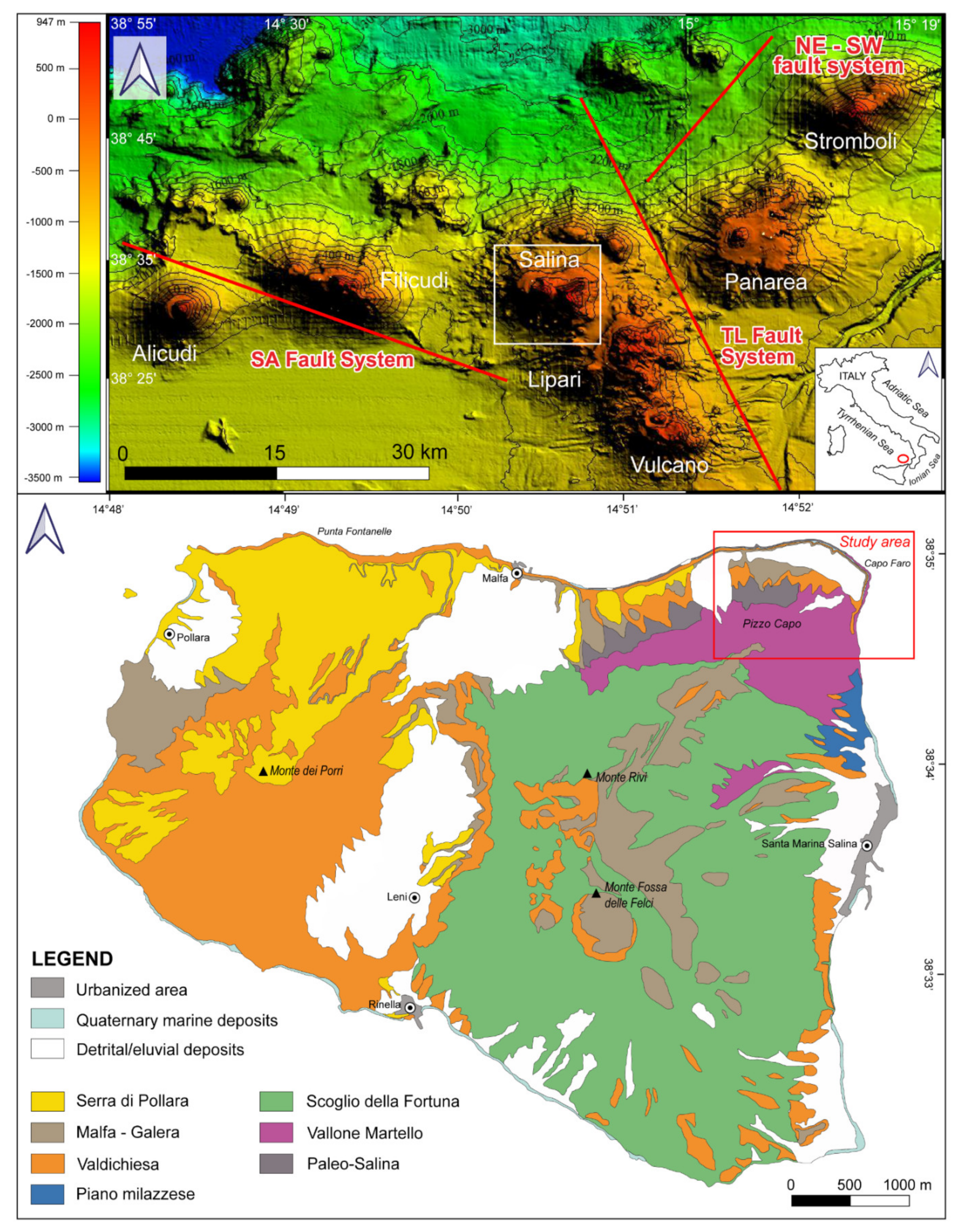
2.2. Salina Volcanological Evolution
2.3. Capo Faro Promontory Structural Features and Stratigraphy
3. Materials and Methods
3.1. Field Survey and UAV Flights
3.2. Structural Analysis
4. Results
4.1. Geomorphological Features

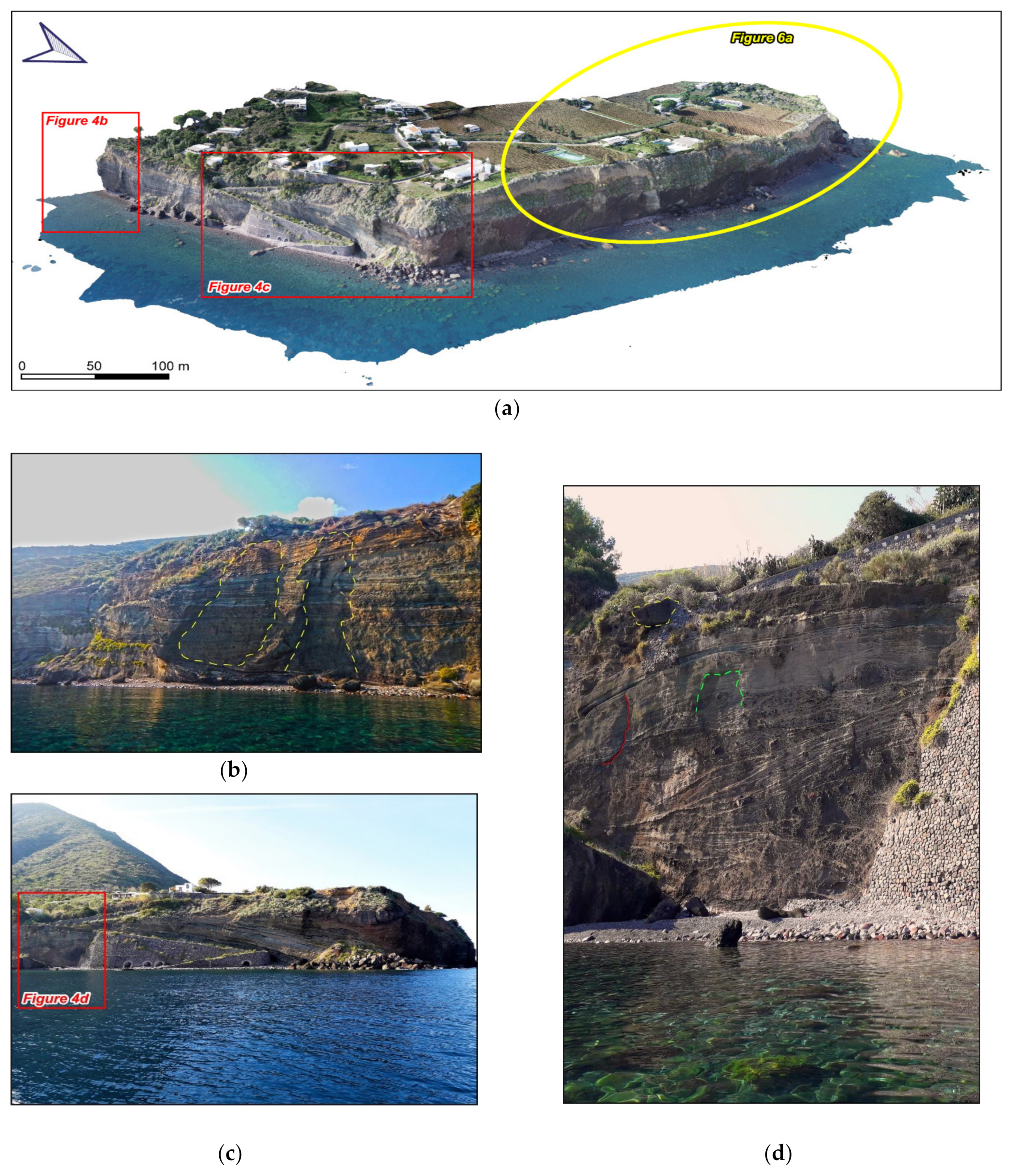
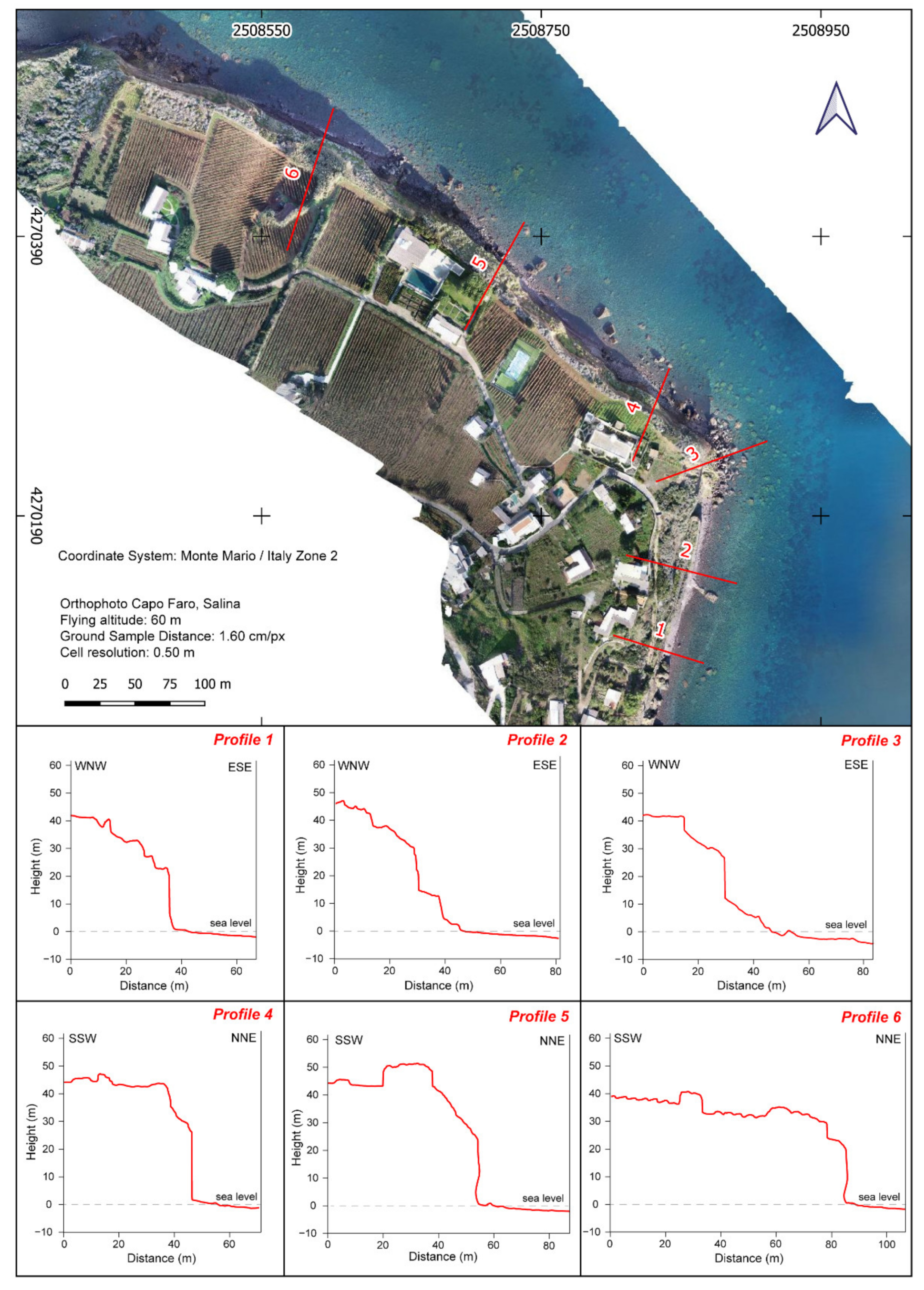

4.2. Cliff Stratigraphy and Structural Assessment
4.3. Slope Stability Analysis
5. Discussions
6. Conclusions
Author Contributions
Funding
Institutional Review Board Statement
Data Availability Statement
Acknowledgments
Conflicts of Interest
Appendix A
| Sample 1 | Sample 2 | Sample 3 | Sample 4 | Mean Value | |
|---|---|---|---|---|---|
| Apparent density (Mg/m3) | 1.31 | 1.32 | 1.30 | 1.29 | 1.31 |
| Apparent density (kN/m3) | 12.85 | 12.94 | 12.75 | 12.65 | 1.80 |
Point Load Measurements
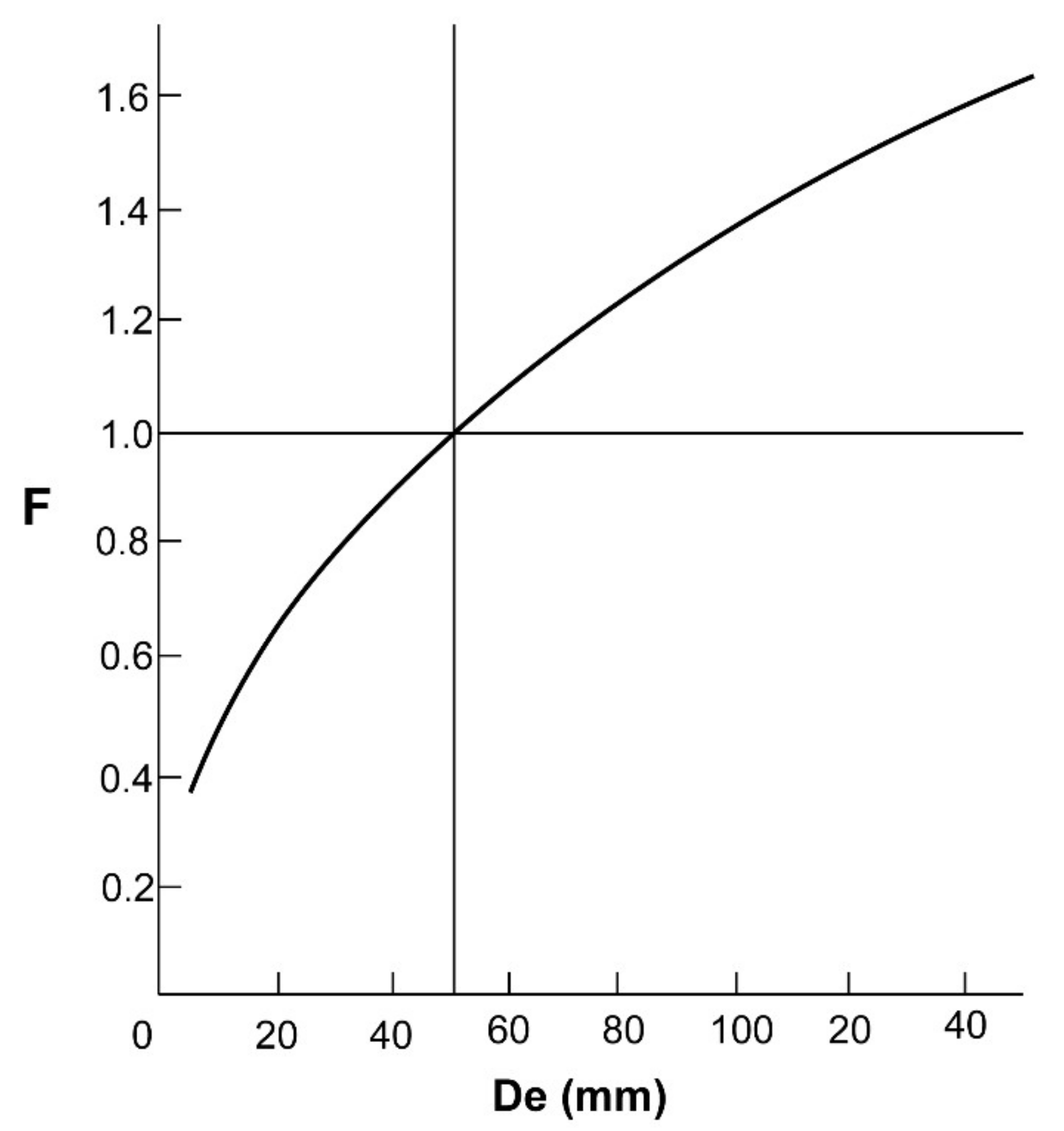
| Sample | Is (kPa) | F | Is (50) | C0 (kPa) | C0 (MPa) | C0 (Kg/cm2) | |
|---|---|---|---|---|---|---|---|
| 1 | 9.35 | 1.39 | 12.97 | 269.78 | 0.27 | 2.75 | |
| 2 | 12.06 | 1.31 | 15.8 | 328.64 | 0.33 | 3.35 | |
| 3 | 13.33 | 1.4 | 18.7 | 388.96 | 0.39 | 3.97 | |
| 4 | 19.8 | 1.23 | 23.48 | 488.38 | 0.49 | 4.98 | |
| 5 | 9.06 | 1.33 | 12.03 | 250.22 | 0.25 | 2.55 | |
| 6 | 9.44 | 1.38 | 130.6 | 271.65 | 0.27 | 2.77 | |
| 7 | 11.66 | 1.26 | 14.63 | 304.3 | 0.3 | 3.1 | |
| 8 | 12.38 | 1.38 | 17.09 | 355.47 | 0.36 | 3.62 | |
| 9 | 9.39 | 1.28 | 12 | 249.6 | 0.25 | 2.55 | |
| 10 | 8.27 | 1.22 | 10.09 | 209.87 | 0.21 | 2.14 | |
| Simple mean | 15 | 311.7 | 0.3 | 3.2 | |||
| Standard deviation | 4 | 28.2 | 0.1 | 1.1 | |||
| Corrected mean | 14.5 | 302.3 | 0.3 | 3.1 | |||
| Corrected standard deviation | 2.5 | 51.4 | 0.1 | 0.5 |
- σ′1 = principal stress, maximum to break;
- σ′3 = principal stress, minimum to break;
- σci = uniaxial compressive strength of the rock;
- mb = rock mass parameter, in the case of intact rocks: mb = mi;
- α = rock mass parameter, in the case of intact rocks: α = 0.5;
- s = rock mass parameter, in the case of intact rocks s = 1;
| Hoek Brown Classification | ||
|---|---|---|
| σci | 5 | Mpa |
| GSI * | 61 | |
| mi | 10 | |
| D | 0 | |
| Ei | 1375 | |
| Hoek Brown criterion | ||
| mb | 2.484 | |
| s | 0.013 | |
| a | 0.503 | |
| Cover break range | ||
| σ3max | 1.25 | MPa |
| Mohr–Coulomb overlap | ||
| c′ | 0.3 | MPa |
| φ′ | 33.74 | degrees |
| Rock mass parameters | ||
| σt | −0.026 | MPa |
| σc | 0.566 | MPa |
| σcm | 1.118 | MPa |
References
- Randazzo, G.; Cascio, M.; Fontana, M.; Gregorio, F.; Lanza, S.; Muzirafuti, A. Mapping of Sicilian Pocket Beaches Land Use/Land Cover with Sentinel–2 Imagery: A Case Study of Messina Province. Land 2021, 10, 678. [Google Scholar] [CrossRef]
- Short, A.D.; Masselink, G. Embayed and Structurally Controlled Beaches. In Handbook of Beach and Shoreface Morphodynamics; Short, A.D., Ed.; Wiley: Hoboken, NJ, USA, 1999; pp. 230–250. [Google Scholar]
- Bini, M.; Mascioli, F.; Pranzini, E. Geomorphological Hazard and Tourist Use of Rocky Coasts in Tuscany (NW Italy). In Proceedings of the 12th European Geoparks Conference, Pisa Coastal Plain, NW Tuscany, Italy, 4–6 September 2013; pp. 34–39. [Google Scholar]
- Violante, C. Rocky coast: Geological constraints for hazard assessment. Geol. Soc. Lond. Spec. Publ. 2009, 322, 1–31. [Google Scholar] [CrossRef]
- Bieniawski, Z.T. Classification of Rock Masses for Engineering: The RMR System and Future Trends. In Comprehensive Rock Engineering; Hudson, J.A., Ed.; Pergamon Press: Oxford, UK, 1993; Volume 3, pp. 553–573. [Google Scholar]
- Carter, R.W.G. Coastal Environments; Academic Press: London, UK, 1988. [Google Scholar]
- Petroccia, A.; Bonasera, M.; Caso, F.; Nerone, S.; Morelli, M.; Bormioli, D.; Moletta, G. Structural and geomorphological framework of the upper Maira Valley (Western Alps, Italy): The case study of the Gollone Landslide. J. Maps 2020, 16, 534–542. [Google Scholar] [CrossRef]
- Redweik, P.; Matildes, R.; Marque, F.; Santos, L. Photogrammetric Methods for Monitoring Cliffs with Low Retreat Rate. J. Coast. Res. 2009, 2, 1577–1581. [Google Scholar]
- Ruberti, D.; Marino, E.; Pignalosa, A.; Romano, P.; Vigliotti, M. Assessment of Tuff Sea Cliff Stability Integrating Geological Surveys and Remote Sensing. Case History from Ventotene Island (Southern Italy). Remote Sens. 2020, 12, 2006. [Google Scholar] [CrossRef]
- Di Crescenzo, G.; Santangelo, N.; Santo, A.; Valente, E. Geomorphological Approach to Cliff Instability in Volcanic Slopes: A Case Study from the Gulf of Naples (Southern Italy). Geosciences 2021, 11, 289. [Google Scholar] [CrossRef]
- Randazzo, G.; Italiano, F.; Micallef, A.; Tomasello, A.; Cassetti, F.P.; Zammit, A.; D’Amico, S.; Saliba, O.; Cascio, M.; Cavallaro, F.; et al. WebGIS Implementation for Dynamic Mapping and Visualization of Coastal Geospatial Data: A Case Study of BESS Project. Appl. Sci. 2021, 11, 8233. [Google Scholar] [CrossRef]
- Barbano, M.; Pappalardo, G.; Pirrotta, C.; Mineo, S. Landslide triggers along volcanic rock slopes in eastern Sicily (Italy). Nat. Hazards 2014, 73, 1587–1607. [Google Scholar] [CrossRef]
- Matano, F.; Caccavalle, M.; Esposito, G.; Fortelli, A.; Scepi, G.; Spano, M.; Sacchi, M. Integrated dataset of deformation measurements in fractured volcanic tuff and meteorological data (Coroglio coastal cliff, Naples, Italy). Earth Syst. Sci. Data 2020, 12, 321–344. [Google Scholar] [CrossRef] [Green Version]
- Lanza, S.; Randazzo, G. Tourist–beach protection in north–eastern Sicily (Italy). J. Coast. Conserv. 2013, 17, 49–57. [Google Scholar] [CrossRef]
- Lanza, S.; Randazzo, G. Improvements to a Coastal Management Plan in Sicily (Italy): New approaches to borrow sediment management. J. Coast. Res. 2011, 64, 1357–1361. [Google Scholar]
- Randazzo, G.; Lanza, S. Regional Plan against Coastal Erosion: A Conceptual Model for Sicily. Land 2020, 9, 307. [Google Scholar] [CrossRef]
- De Astis, G.; Ventura, G.; Vilardo, G. Geodynamic significance of the Aeolian volcanism (Southern Tyrrhenian Sea, Italy) in light of structural, seismological, and geochemical data. Tectonics 2003, 22, 1040. [Google Scholar] [CrossRef]
- Santo, A.P.; Clark, A.H. Volcanological Evolution of Aeolian Arc (Italy): Inferences from 40Ar/39Ar ages of Filicudi Rocks. In Proceedings of the IAVCEI Congress, Ankara, Turkey, 12–16 September 1994. [Google Scholar]
- Barberi, F.; Innocenti, F.; Ferrara, G.; Keller, J.; Villari, L. Evolution of Eolian Arc volcanism (Southern Tyrrhenian Sea). Earth Planet. Sci. Lett. 1974, 21, 269–276. [Google Scholar] [CrossRef]
- Beccaluva, L.; Rossi, P.L.; Serri, G. Neogene to Recent volcanism of the Southern Tyrrhenian–Sicilian area: Implications for the geodynamic evolution of the Calabrian Arc. Earth Evol. Sci. 1982, 3, 222–238. [Google Scholar]
- Beccaluva, L.; Gabbianelli, G.; Lucchini, F.; Rossi, P.L.; Savelli, C. Petrology and K/Ar ages of volcanic dredged from the Eolian seamounts: Implications for geodynamic evolution of the Southern Tyhrrenian basin. Earth Planet. Sci. Lett. 1985, 74, 187–208. [Google Scholar] [CrossRef]
- Ferrari, L.; Manetti, P. Geodynamic framework of the Tyrrhenian volcanism: A review. Acta Vulcanol. 1993, 3, 1–10. [Google Scholar]
- Westaway, R. Quaternary uplift of southern Italy. J. Geophys. Res. 1993, 98, 21741–21772. [Google Scholar] [CrossRef]
- Hippolyte, J.; Angelier, J.; Roure, F. A major change revealed by Quaternary stress patterns in the Southern Apennines. Tectonophysics 1994, 230, 199–210. [Google Scholar] [CrossRef]
- Milano, G.; Vilardo, G.; Luongo, G. Continental collision and basin opening in southern Italy: A new plate subduction in the Tyrrhenian Sea? Tectonophysics 1994, 230, 249–264. [Google Scholar] [CrossRef]
- Carminati, E.; Wortel, M.J.R.; Spakman, W.; Sabadini, R. The role of slab detachment processes in the opening of the western–central Mediterranean basins: Some geological and geophysical evidence. Earth Planet. Sci. Lett. 1998, 160, 651–665. [Google Scholar] [CrossRef]
- Ventura, G. Kinematics of the Aeolian volcanism (Southern Tyrrhenian Sea) from geophysical and geological data. In The Aeolian Islands Volcanoes; Lucchi, F., Peccerillo, A., Keller, J., Tranne, C.A., Rossi, P.L., Eds.; Memoirs Geological Society: London, UK, 2013; Volume 37, pp. 3–11. [Google Scholar] [CrossRef]
- Bortoluzzi, G.; Ligi, M.; Romagnoli, C.; Cocchi, L.; Casalbore, D.; Sgroi, T.; Cuffaro, M.; Tontini, F.C.; D’Oriano, F.; Ferrante, V.; et al. Interactions between Volcanism and Tectonics in the Western Aeolian Sector, Southern Tyrrhenian Sea. Geophys. J. Int. 2010, 183, 64–78. [Google Scholar] [CrossRef] [Green Version]
- Neri, G.; Barberi, G.; Orecchio, B.; Mostaccio, A. Seismic strain and seismogenic stress regimes in the crust of the southern Tyrrhenian region. Earth Planet. Sci. Lett. 2003, 213, 97–112. [Google Scholar] [CrossRef]
- D’Agostino, N.; Selvaggi, G. Crustal motion along the Eurasia–Nubia plate boundary in the Calabrian Arc and Sicily and active extension in the Messina Straits from GPS measurements. J. Geophys. Res. 2004, 109, B11402. [Google Scholar] [CrossRef]
- Lucchi, F.; Tranne, C.A.; Keller, J.; Gertisser, R.; Forni, F.; De Astis, G. Geological Map of the Island of Salina, Scale 1:10,000 (Aeolian Archipelago). In The Aeolian Islands Volcanoes; Lucchi, F., Peccerillo, A., Keller, J., Tranne, C.A., Rossi, P.L., Eds.; Memoirs Geological Society: London, UK, 2013; Volume 37, pp. 155–211. [Google Scholar]
- Lucchi, F.; Gertisser, R.; Keller, J.; Forni, F.; De Astis, G.; Tranne, C.A. Eruptive History and Magmatic Evolution of the Island of Salina (Central Aeolian Archipelago). In The Aeolian Islands Volcanoes; Lucchi, F., Peccerillo, A., Keller, J., Tranne, C.A., Rossi, P.L., Eds.; Memoirs Geological Society: London, UK, 2013; Volume 37, pp. 155–211. [Google Scholar]
- Mazzuoli, R.; Tortorici, L.; Ventura, G. Oblique rifting in Salina, Lipari and Vulcano Islands (Aeolian Islands, Southern Tyrrhenian Sea, Italy). Terra Nova 1995, 7, 444–452. [Google Scholar] [CrossRef]
- Continisio, R.; Ferrucci, F.; Gaudiosi, G.; Lo Bascio, D.; Ventura, G. Malta escarpment and Mt. Etna: Early stages of an asymmetric rifting process? Evidences from geophysical and geological data. Acta Vulcanol. 1997, 9, 39–47. [Google Scholar]
- Lanzafame, G.; Bousquet, J.C. The Maltese escarpment and its extension from Monte Etna to Aeolian Islands (Sicily): Importance and evolution of a lithospheric discontinuity. Acta Vulcanol. 1997, 9, 121–135. [Google Scholar]
- Romagnoli, C.; Casalbore, D.; Bortoluzzi, G.; Bosman, A.; Chiocci, F.L.; D’Oriano, F.; Gamberi, F.; Ligi, M.; Marani, M. Bathy–mortphological setting of the Aeolian islands. In The Aeolian Islands Volcanoes; Lucchi, F., Peccerillo, A., Keller, J., Tranne, C.A., Rossi, P.L., Eds.; Memoirs Geological Society: London, UK, 2013; Volume 37, pp. 27–36. [Google Scholar] [CrossRef]
- Keller, J. Die Geologie der Insel Salina. Ph.D. Thesis, Albert–Ludwigs–Universitat Freiburg, Breisgau, Germany, 1966. Unpublished. [Google Scholar]
- Keller, J.; Ryan, W.B.F.; Ninkovich, D.; Altherr, R. Explosive volcanic activity in the Mediterranean over the past 200.000 yr as recorded in deep–sea sediment. Geol. Soc. Am. Bull. 1978, 89, 591–604. [Google Scholar] [CrossRef]
- Morche, W. Tephrochronologie der Äolischen Inseln. Ph.D. Thesis, Albert–Ludwigs–Universitat Freiburg, Breisgau, Germany, 1988. Unpublished. [Google Scholar]
- Lucchi, F.; Tranne, C.A.; De Astis, G.; Keller, J.; Losito, R.; Morche, W. Stratigraphy and significance of Brown Tuffs on the Aeolian Islands (southern Italy). J. Volcanol. Geoth. Res. 2008, 177, 49–70. [Google Scholar] [CrossRef]
- Keller, J. The Island of Salina. Rend. Della Soc. Ital. Di Mineral. E Petrol. 1980, 36, 489–524. [Google Scholar]
- Quareni, F.; Ventura, G.; Mulargia, F. Numerical modelling of the transition from fissure– to central–type activity on volcanoes: A case study from Salina Island, Italy. Phys. Earth Planet. Inter. 2001, 124, 213–221. [Google Scholar] [CrossRef]
- Barca, D.; Ventura, G. Evoluzione vulcano–tettonica dell’isola di Salina (arcipelago delle Eolie). Mem. Della Soc. Geol. Ital. 1991, 47, 401–415. [Google Scholar]
- Tarquini, S.; Nannipieri, L. The 10–m resolution TINITALY DEM as a trans–disciplinary basis for the analysis of the Italian territory: Current trends and new perspectives. Geomorphology 2017, 281, 108–115. [Google Scholar] [CrossRef]
- Cruden, D.M.; Varnes, D.J. Landslide types and processes. In Landslides Investigation and Mitigation. Transportation Research Board; Turner, A.K., Schuster, R.L., Eds.; Special Report 247; US National Research Council: Whashington, DC, USA, 1996; Chapter 3; pp. 36–75. [Google Scholar]
- Carrivick, J.L.; Smith, M.W.; Quincey, D.J. Structure from Motion in Practice. In Structure from Motion in the Geosciences; John Wiley & Sons, Ltd.: New York, NY, USA, 2016; pp. 60–96. [Google Scholar] [CrossRef]
- Ullman, S. The interpretation of Structure from Motion. Proc. R. Soc. Lond. Ser. B Biol. Sci. 1979, 203, 405–426. Available online: https://www.jstor.org/stable/77505 (accessed on 26 June 2022).
- Casella, E.; Rovere, A.; Pedroncini, C.P.; Stark, M.; Casella, M.; Ferrari, M.; Firpo, M. Drones as tools for monitoring beach topography changes in the Ligurian Sea (NW Mediterrenean). Geo–Mar. Lett. 2016, 36, 151–163. [Google Scholar] [CrossRef]
- Markland, J.T. A useful technique for estimating the stability of rock slopes when the rigid wedge slide type of failure is expected. Imp. Coll. Rock Mech. Res. Repr. 1972, 19, 1–10. [Google Scholar]
- Goodman, R.E.; Bray, J.W. Toppling of Rock Slopes. In Proceedings of the Specialty Conference Rock Engineering for Foundations and Slopes, American Society of Civil Engineers, Boulder, CO, USA, 15–18 August 1976; pp. 201–234. [Google Scholar]
- Goodman, R.E. Introduction to Rock Mechanics; Wiley: Hoboken, NJ, USA, 1980; p. 478. [Google Scholar]
- Rusnak, J.; Mark, C. Using the Point Load Test to Determine the Uniaxial Compressive Strength of Coral Measure Rock. In Proceedings of the 19th International Conference on Ground Control in Mining, Morgantown, WV, USA, 8–10 August 2000; pp. 362–371. [Google Scholar]
- Hoek, E.; Brown, E.T. Empirical strength criterion for rock masses. J. Geotech. Eng. Div. 1980, 106, 1013–1035. [Google Scholar] [CrossRef]
- Hoek, E.; Carranza, C.; Itasca, T. Hoek–Brown Failure Criterion–2002 Edition. In Proceedings of the North American Rock Mechanics Society Meeting, Toronto, ON, Canada, 7–10 July 2002. [Google Scholar]
- Bieniawski, Z.T. Rock mass Classification in Rock Engineering. In Exploration for Rock Engineering; Balkema: Cape Town, South Africa, 1976; Volume 1, pp. 97–106. [Google Scholar]
- Bieniawski, Z.T. Determining rock mass deformability. Int. J. Rock Mech. Min. Sci. 1978, 15, 335–343. [Google Scholar] [CrossRef]
- Bieniawski, Z.T. Engineering Rock Mass Classifications: A Complete Manual for Engineers and Geologists in Mining, Civil, and Petroleum Engineering; Wiley–Interscience: New York, NY, USA, 1989; pp. 40–47. ISBN 0-471-60172-1. [Google Scholar]

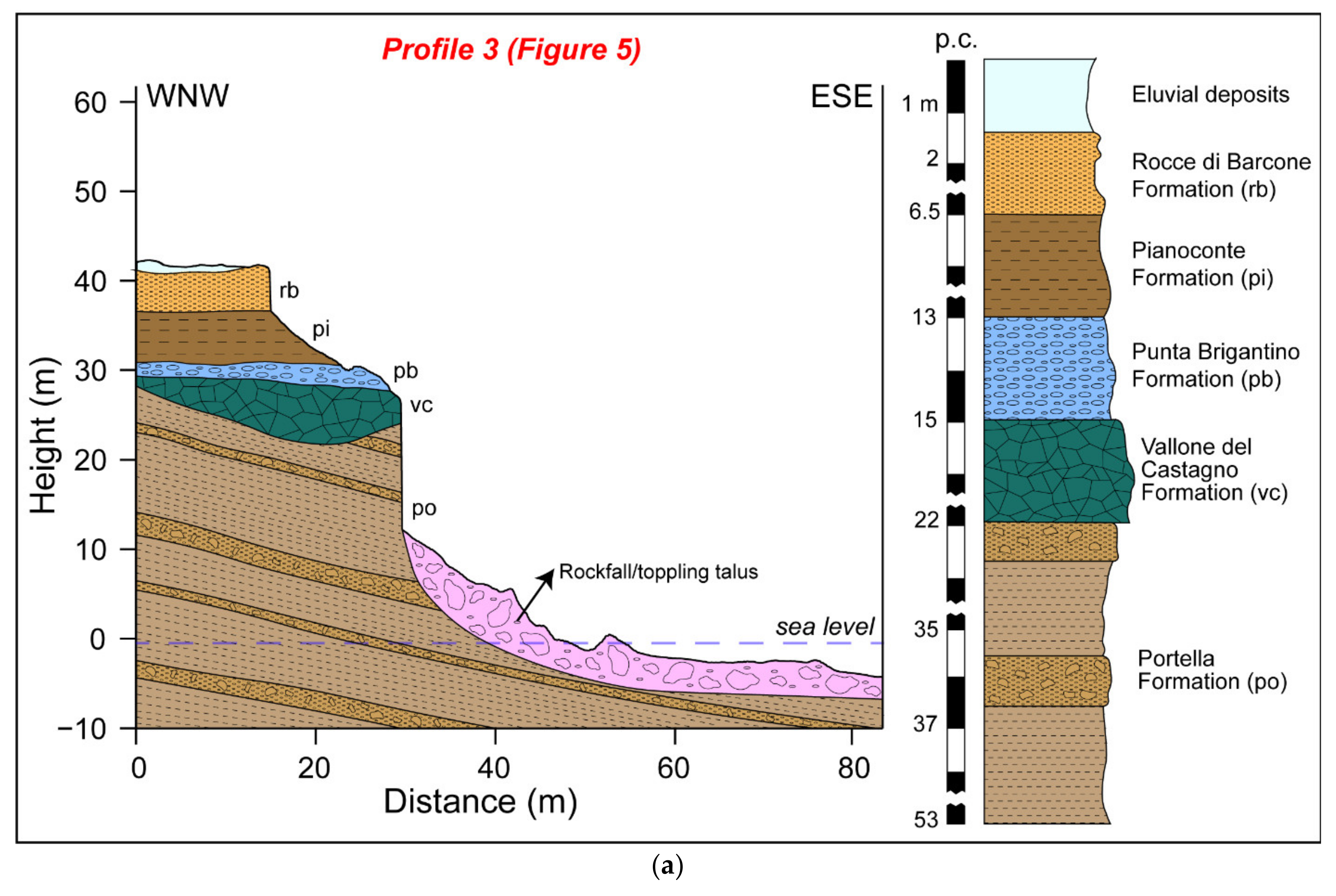

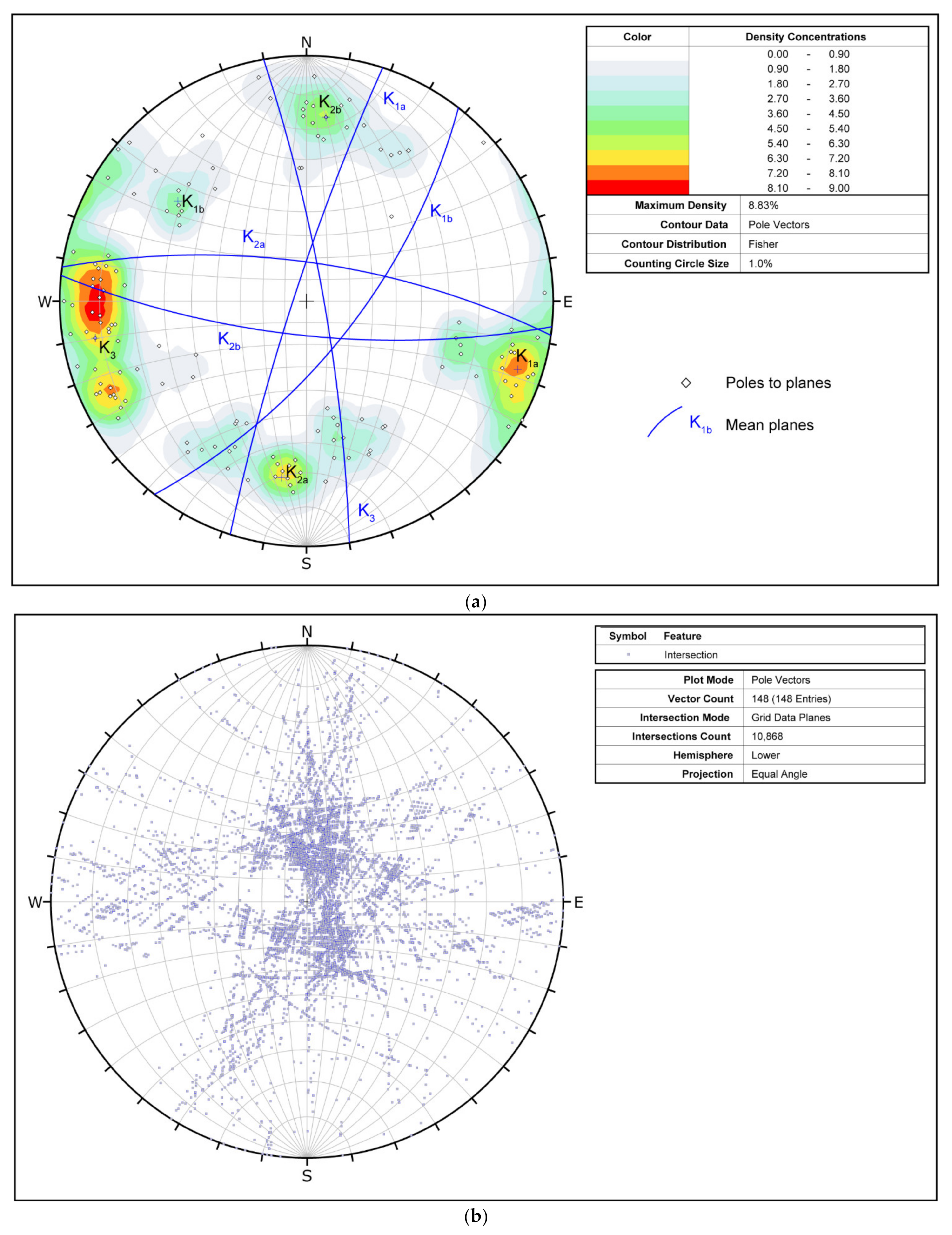
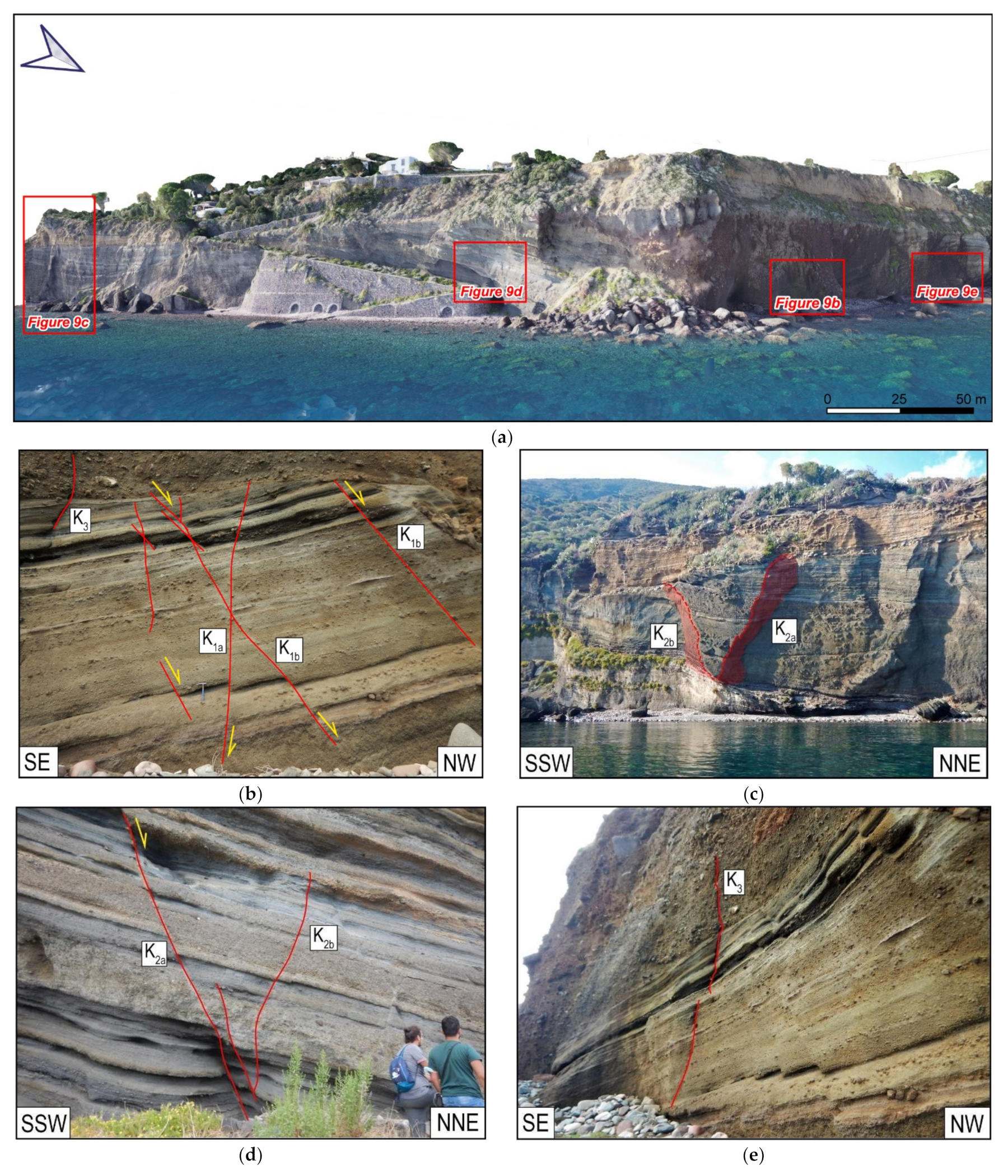
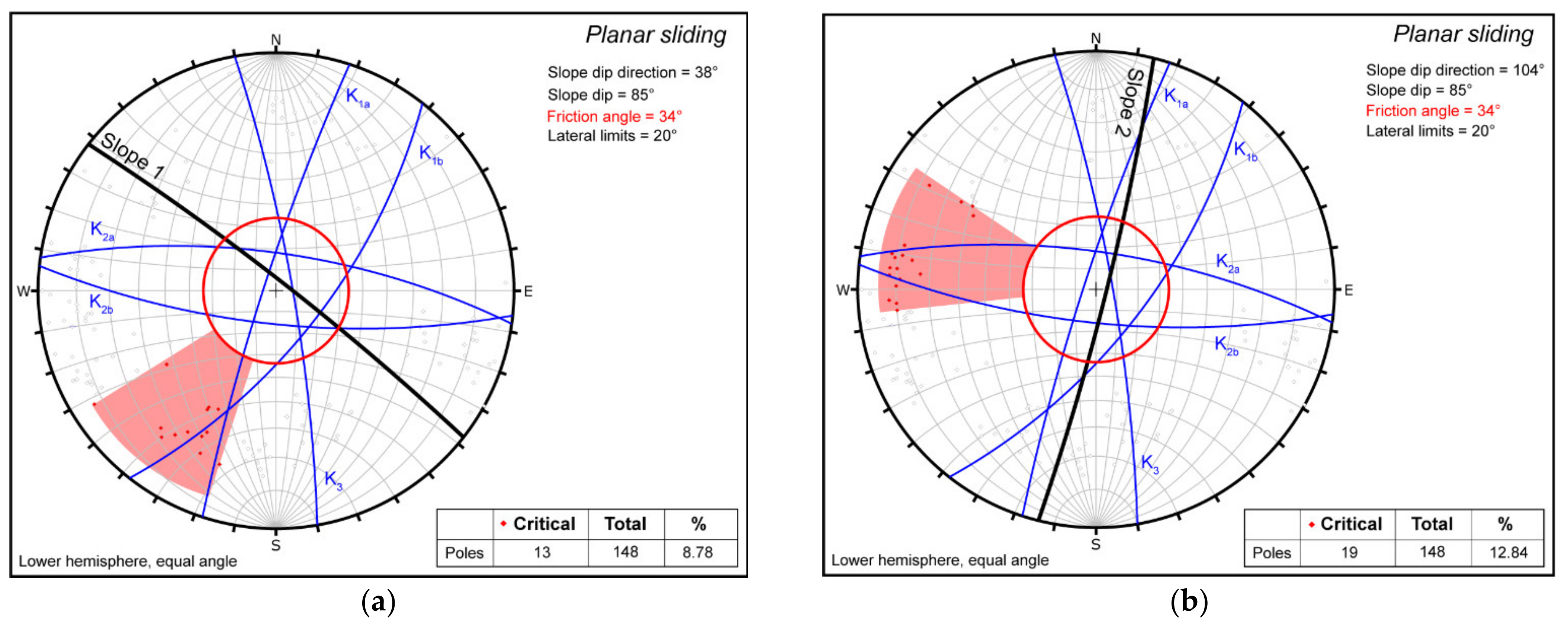
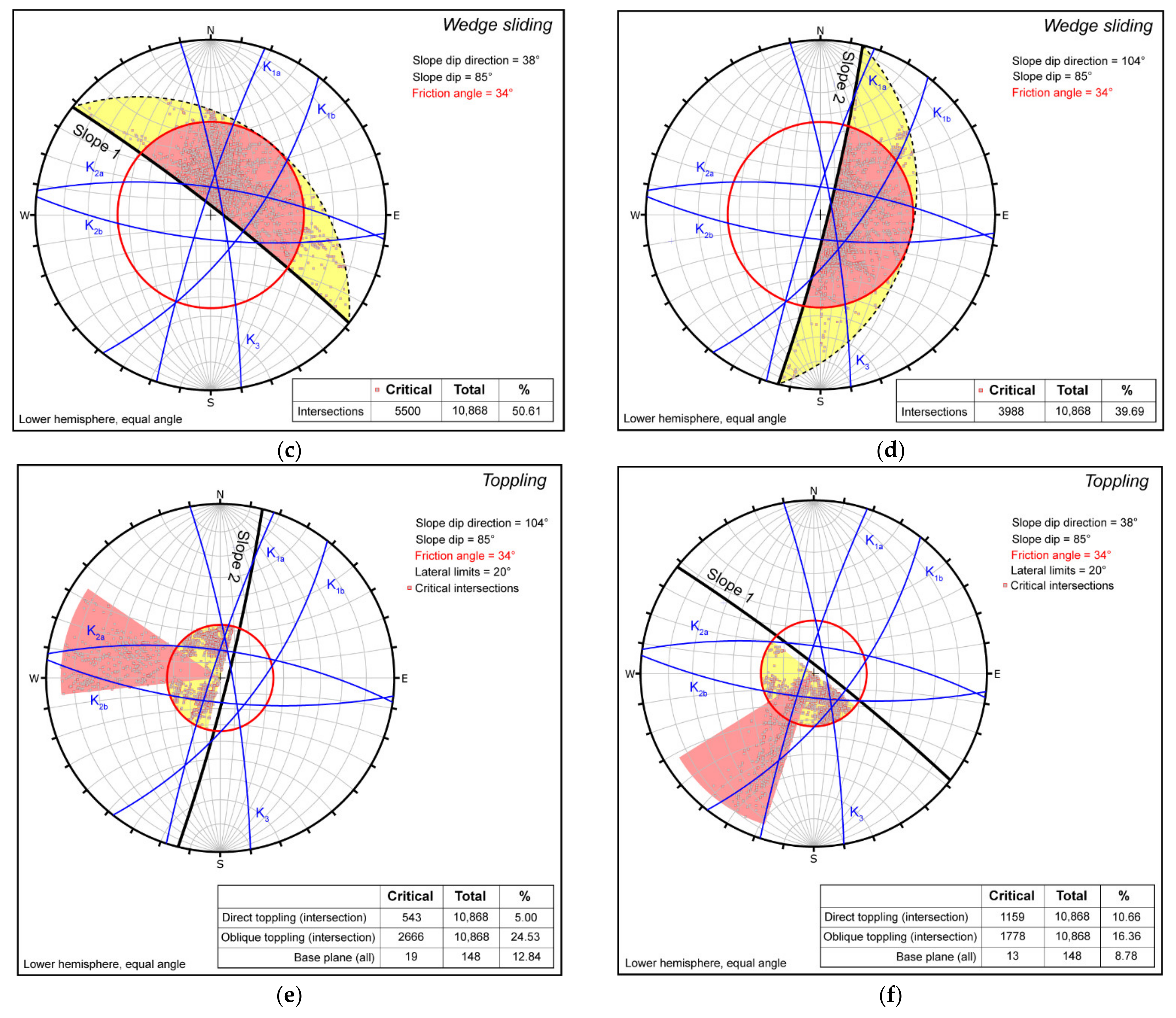
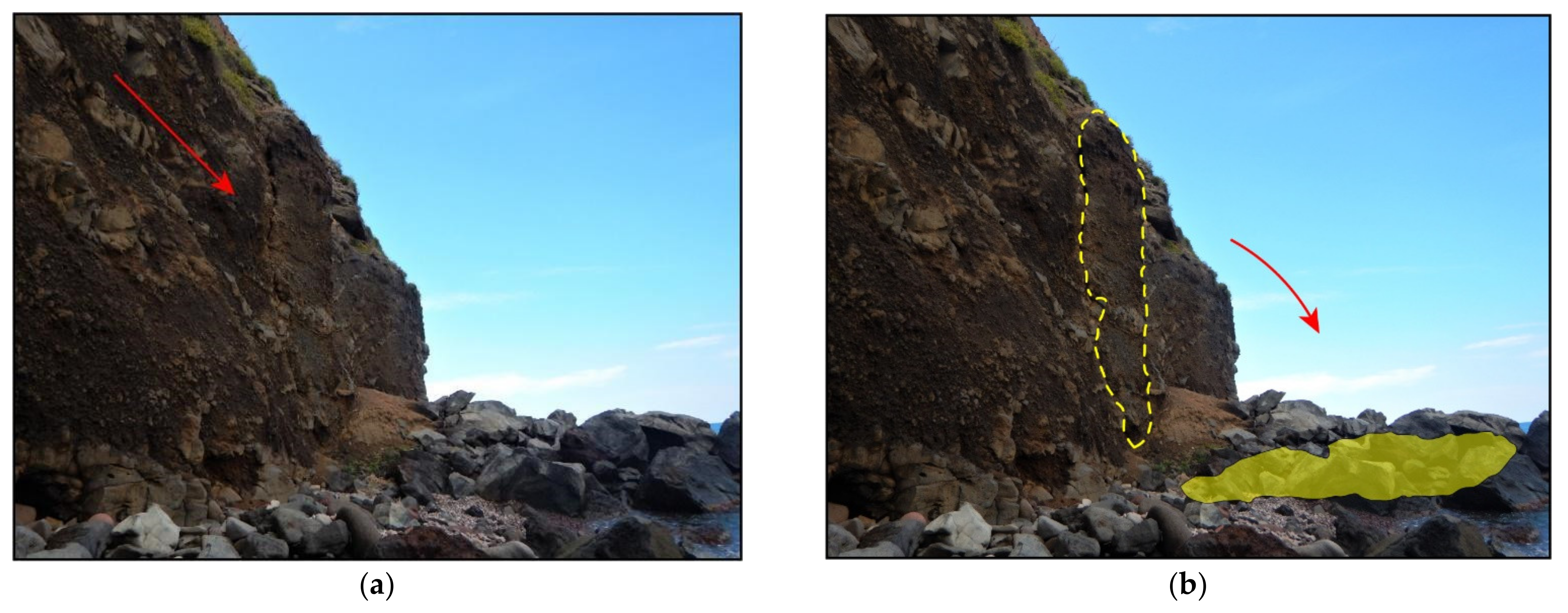
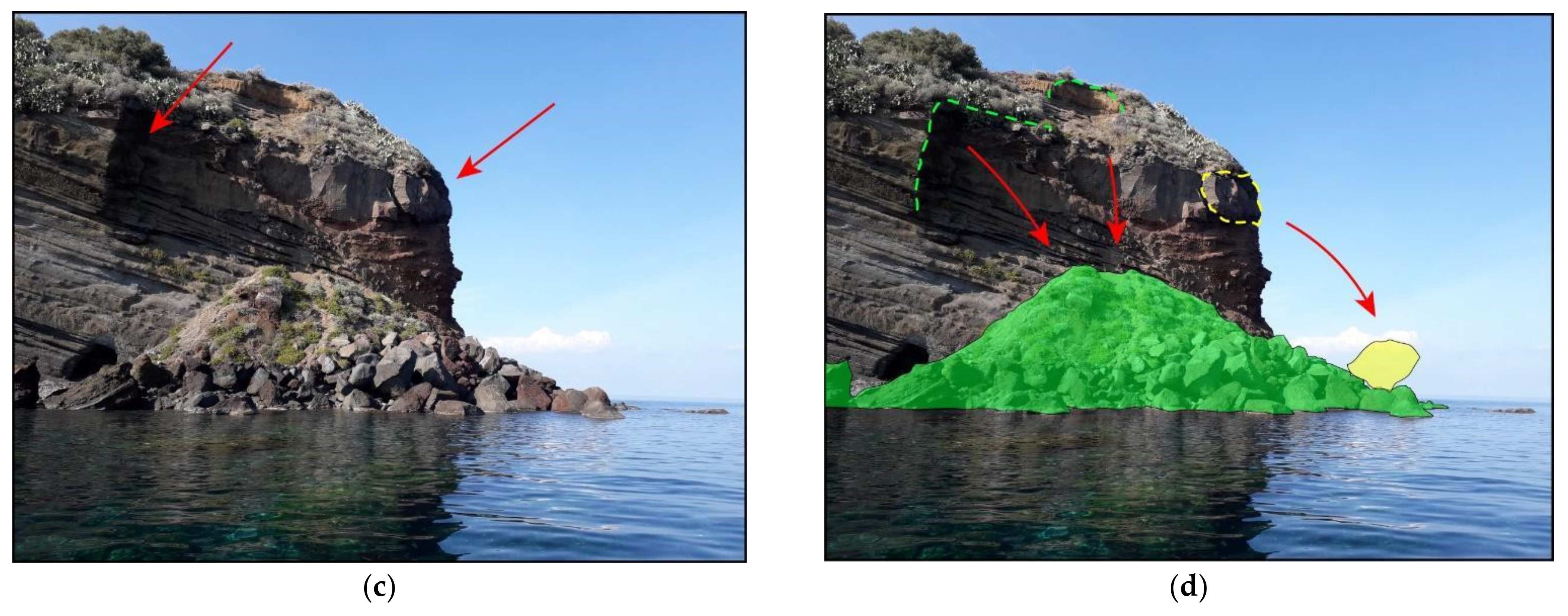
| Eruptive Epoch | Synthem | Volcanic Vent | Formation | Description | Age |
|---|---|---|---|---|---|
| VI | – | (Vulcano Island) | Piano Grotte dei Rossi | Ash tuffs in a massive brownish shape up to 2 m of thickness | n.d. |
| VI | Serra di Pollara | Pollara | Punta di Fontanelle | Pumiceous pyroclastic deposits (30–40 m thick) | 27.5 ky |
| V | Valdichiesa | Monte dei Porri | Serra di Sciarato | Two members: (i) massive CA basaltic andesite lava flow, 5–10 m thick; (ii) scoriaceous deposits, up to several metres thick | n.d. |
| V | Valdichiesa | Monte dei Porri | Rocce di Barcone | Pyroclastic deposits 50–70 m–thick, made of two facies: (i) massive proximal with lots of lithics; (ii) distal with stratified lapilli/tuffs in thin layers and planar to cross–stratified tuffs | 72.7–67.9 ky |
| V | – | (Vulcano Island) | Pianoconte | Distal fallout deposits made of massive ash tuff, 5–7 m of thickness | n.d. |
| Q.P. 1 | Fontanelle | – | Punta Brigantino | Poorly sorted, a coarse conglomerate with rounded pebbles and boulders up to 1.5 m in size (3–4 m–thick). The erosional basal contact is referable to the marine transgression of MIS 5c and 5a | 100–81 ky |
| Q.P. | Piano Milazzese | – | Serro dell’Acqua | Volcanic re–worked debris deposits up to 20 m–thick | 110–105 ky |
| III | Scoglio della Fortuna | Monte Rivi | Vallone del Castagno | Pyroclastic succession made up of alternated thin layers of incoherent, massive pyroclastic breccias of reddish scoria, and planar to cross–stratified lapilli–tuff beds up to 50 m–thick. In Capo Faro Promontory crops out as a massive lava flow | ca. 168 ky |
| II | Vallone Martello | Pizzo Capo | Portella | Up to 120 m–thick successions of scoria with the alternation of metre–thick layers with planar–stratified fallout deposits | ca. 240 ky |
| II | Vallone Martello | Pizzo Capo | Piano del Serro del Capo | Scoriaceous pyroclastic succession up to 15 m–thick, made by an alternation of massive lithic–rich beds with tuff–breccias and lava flows | n.d. |
| I | Paleo–Salina | Pizzo Capo | Torricella | Poorly bedded fallout and volcanic debris deposits with discontinuous interbedded massive lava flow | n.d. |
Publisher’s Note: MDPI stays neutral with regard to jurisdictional claims in published maps and institutional affiliations. |
© 2022 by the authors. Licensee MDPI, Basel, Switzerland. This article is an open access article distributed under the terms and conditions of the Creative Commons Attribution (CC BY) license (https://creativecommons.org/licenses/by/4.0/).
Share and Cite
Bonasera, M.; Cerrone, C.; Caso, F.; Lanza, S.; Fubelli, G.; Randazzo, G. Geomorphological and Structural Assessment of the Coastal Area of Capo Faro Promontory, NE Salina (Aeolian Islands, Italy). Land 2022, 11, 1106. https://doi.org/10.3390/land11071106
Bonasera M, Cerrone C, Caso F, Lanza S, Fubelli G, Randazzo G. Geomorphological and Structural Assessment of the Coastal Area of Capo Faro Promontory, NE Salina (Aeolian Islands, Italy). Land. 2022; 11(7):1106. https://doi.org/10.3390/land11071106
Chicago/Turabian StyleBonasera, Mauro, Ciro Cerrone, Fabiola Caso, Stefania Lanza, Giandomenico Fubelli, and Giovanni Randazzo. 2022. "Geomorphological and Structural Assessment of the Coastal Area of Capo Faro Promontory, NE Salina (Aeolian Islands, Italy)" Land 11, no. 7: 1106. https://doi.org/10.3390/land11071106
APA StyleBonasera, M., Cerrone, C., Caso, F., Lanza, S., Fubelli, G., & Randazzo, G. (2022). Geomorphological and Structural Assessment of the Coastal Area of Capo Faro Promontory, NE Salina (Aeolian Islands, Italy). Land, 11(7), 1106. https://doi.org/10.3390/land11071106











